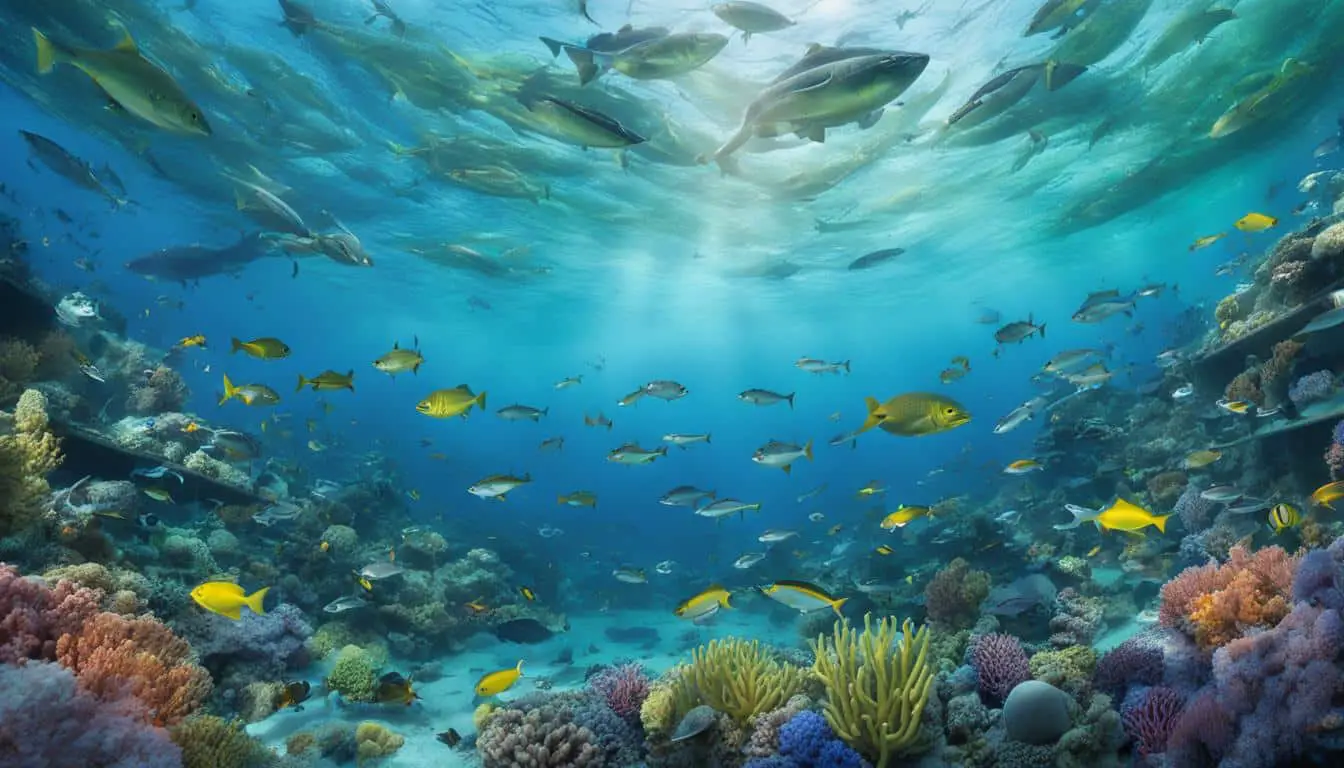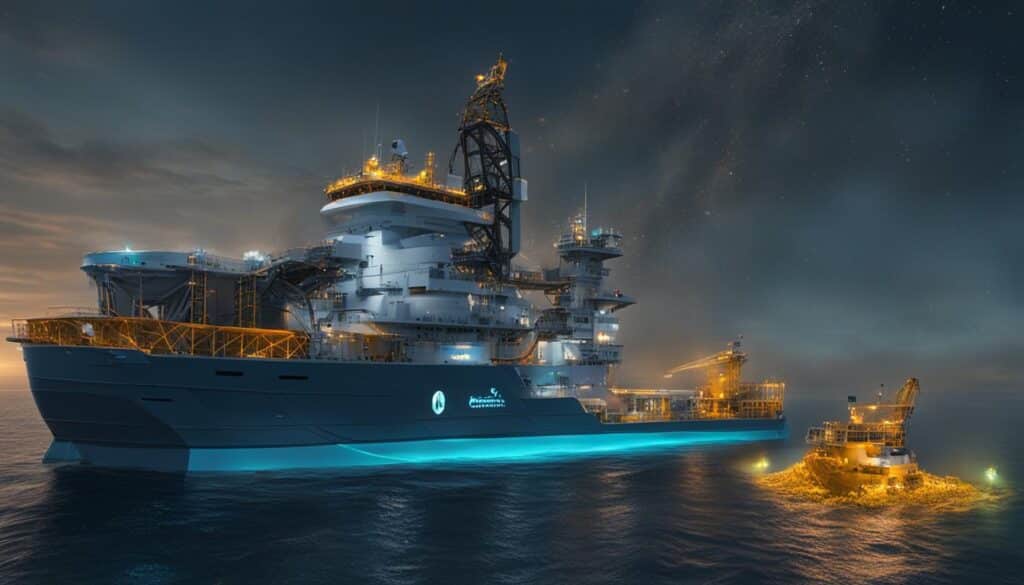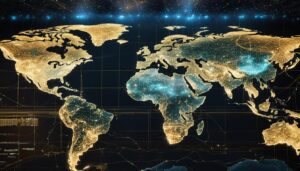
Artificial intelligence (AI) algorithms have revolutionized scientific research in various fields, and oceanography is no exception. With their ability to process large amounts of data and analyze complex patterns, AI algorithms offer valuable insights into marine ecosystems. In this section, we will explore the applications of AI in oceanography, focusing on the analysis of marine ecosystems and the potential benefits of using AI-driven technologies.
Key Takeaways:
- AI algorithms play a crucial role in analyzing marine ecosystems by processing vast amounts of data and identifying complex patterns.
- Applications of AI in oceanography include monitoring marine biodiversity, modeling deep-sea resources, and predicting ocean parameters.
- AI-driven technologies provide valuable insights into the behavior of the oceans and their impact on climate change.
- AI also contributes to the conservation of marine ecosystems by monitoring coral reefs, tracking marine animal movements, and detecting illegal fishing activities.
- The future of AI in marine research holds great potential for advancing our understanding and protecting these fragile ecosystems.
Monitoring Marine Biodiversity with AI Algorithms
AI algorithms have revolutionized the way we monitor marine biodiversity. Through the use of deep learning models, researchers can now automatically identify and classify species based on acoustic data, images, and videos. This advanced technology allows for a more efficient and accurate analysis of marine ecosystems.
“AI algorithms enable us to process vast amounts of data and extract meaningful patterns and insights. By using deep learning models, we can train neural networks to recognize specific species and distinguish them from similar ones, contributing to our understanding of marine biodiversity.”
One notable application of AI in marine biodiversity monitoring is the identification of humpback whale songs. Researchers have trained deep convolutional neural networks to analyze acoustic data collected over a long period of time, achieving high accuracy in identifying and tracking these unique vocalizations.
In addition to acoustic data, AI algorithms are also being used to analyze images and videos of underwater environments. By combining machine learning and deep learning networks, researchers can annotate and analyze these visual data, providing comprehensive information on the spatial distribution and temporal dynamics of marine life. This level of analysis was previously time-consuming and labor-intensive, but AI-powered tools have made it more efficient and precise.
Overall, the integration of AI algorithms in monitoring marine biodiversity has greatly improved our ability to understand and protect marine ecosystems. By harnessing the power of deep learning models, researchers can effectively analyze large volumes of data and contribute to the conservation efforts of our oceans.
| Advantages | Challenges |
|---|---|
|
|
Modeling Deep-Sea Resources Using AI
Artificial intelligence (AI) algorithms have opened up new possibilities for modeling deep-sea resources, allowing researchers to gain a deeper understanding of the distribution and characteristics of valuable underwater assets. By leveraging AI algorithms and a 3D modeling approach, scientists are able to estimate the volume distribution of resources such as cobalt-rich manganese crusts and generate accurate reconstructions of the seafloor.
The use of AI algorithms in modeling deep-sea resources is particularly important for resource management and exploration efforts. These algorithms can process vast amounts of multi-modal sensor data and apply machine learning techniques to generate comprehensive insights. For example, AI-driven modeling has been successful in estimating the extent and concentration of cobalt-rich manganese crusts, which are an important source of metals for renewable energy technologies. This information helps guide decision-making processes related to resource extraction and conservation.
In addition to resource estimation, AI algorithms are also enhancing the accuracy and realism of ocean ray tracing. By utilizing generative adversarial networks (GANs), researchers can simulate realistic scenes of light propagation in the ocean, minimizing processing artifacts and improving the quality of visualizations. This advancement is crucial in fields such as underwater imaging and remote sensing, where accurate modeling of light interaction with the ocean is essential.
The Potential of AI in Deep-Sea Resource Modeling
The integration of AI algorithms into the field of deep-sea resource modeling has the potential to revolutionize our understanding of these valuable assets. AI-driven approaches can provide valuable insights into the distribution, concentration, and characteristics of resources, enabling more informed decision-making and sustainable management practices.
By combining AI algorithms, multi-modal sensor data, and advanced modeling techniques, researchers can unlock the secrets of the deep sea and harness its resources in a responsible and efficient manner. As technology continues to advance, we can expect AI to play an increasingly important role in deep-sea resource modeling, contributing to the sustainable development and conservation of our oceanic ecosystems.

| Deep-Sea Resource | Method | Advancements |
|---|---|---|
| Cobalt-rich Manganese Crusts | AI algorithms with 3D modeling | Estimation of volume distribution Accurate reconstruction of seafloor |
| Ocean Ray Tracing | Generative adversarial networks (GANs) | Realistic scenes with minimal artifacts Improvement in light propagation modeling |
Conclusion
The incorporation of artificial intelligence (AI) in oceanography and marine research has the potential to revolutionize our understanding of marine ecosystems. AI algorithms can process vast amounts of data and analyze complex patterns, enabling researchers like me to monitor marine biodiversity, model deep-sea resources, and predict ocean parameters with greater accuracy.
AI-driven technologies, such as autonomous underwater vehicles (AUVs) and climate modeling, are providing valuable insights into the behavior of the oceans and their impact on climate change. By leveraging AI, we can study the intricate interactions between various factors and predict future scenarios, helping us make informed decisions for sustainable ocean management.
The future of AI in marine research holds immense promise. Researchers are exploring AI applications in climate change research, using AI algorithms to analyze vast datasets and uncover the intricate connections between the oceans and the Earth’s climate system. This knowledge can aid in understanding climate change patterns, predicting future changes, and devising effective mitigation strategies.
Furthermore, AI plays a crucial role in the conservation of marine ecosystems. By monitoring the health of coral reefs, tracking marine animal movements, and detecting illegal fishing activities, AI technologies help protect vulnerable species and preserve biodiversity. They empower us to take proactive measures for the sustainable management and conservation of our oceans.
FAQ
What is the role of AI algorithms in monitoring marine biodiversity?
AI algorithms are used to automatically identify and classify species based on acoustic data, images, and videos. They can analyze large amounts of data and provide valuable insights into the spatial distribution and temporal dynamics of marine ecosystems.
How are AI algorithms being applied in modeling deep-sea resources?
By combining multi-modal sensor data and machine learning techniques, AI algorithms can estimate the volume distribution of resources like cobalt-rich manganese crusts and generate 3D reconstructions of the seafloor. These modeling methods aid in resource management and exploration efforts.
What are the potential benefits of using AI in understanding marine environments?
AI algorithms can process vast amounts of data and analyze complex patterns, enabling researchers to monitor marine biodiversity, model deep-sea resources, and predict ocean parameters with greater accuracy. AI-driven technologies provide valuable insights into the behavior of the oceans, their impact on climate change, and aid in the conservation of marine ecosystems.
Source Links
- https://www.frontiersin.org/articles/10.3389/fmars.2022.920994
- https://ts2.space/en/the-future-of-ai-in-oceanography-and-marine-research/
- https://www.frontiersin.org/articles/10.3389/feart.2023.1090185








